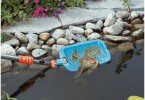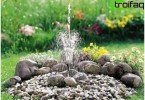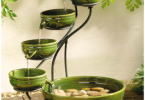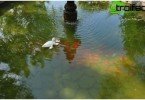Owners of their own piece of land are lucky, because they can build a personal reservoir. It can be like a tiny fountain, a modest pool, or a huge pond where you will invite your bosom friends to fish. It all depends on the size of the territory, your desire, imagination and financial capabilities. However, building a pond is half the battle. In order for it to function normally, it must be properly looked after. The first thing to think about is the filter for the pond – a mandatory attribute of a water structure.
Content
- Why ponds need to be cleaned
- What are filters for ponds
- Getting to know the filters
- How to make a homemade water purification filter
Why ponds need to be cleaned
As you know, Mother Nature lives her natural life, if you built your own pond on its territory, you will have to make friends with the mischievous girl. To study her habits, watch pranks, try to work as a “duet”. Some estate owners believe that it’s enough to build a reservoir, and then nature itself will take the water oasis under its “protection”, but they are mistaken, because your creation is artificial, so at least you need to agree with the environment about the “subscription service”. Nature pleases you with its environment, you take good care of the pond – the result is a fruitful joint project called “the pond of your dreams”.
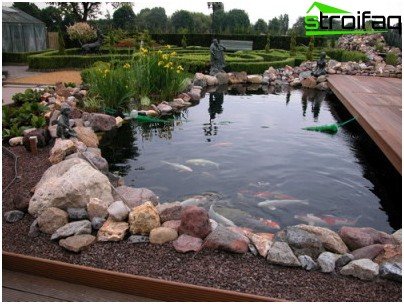
A well-kept pond is the pride of the owners of the site, isn’t it?!
By the way, the reasons for the pollution of the reservoir can be not only the “tricks” of prankish nature, but also your “initiative” associated with equipping and maintaining the pond. So why does water lose its purity?
- The pond is under the active rays of the sun (not in the shade), which provokes the flowering of water.
- You did not pre-disinfect the water or did it incorrectly.
- The water in the pond is stagnant (the pond is not equipped with a pump), which leads to increased growth of algae and flowering water.
- The pond is “overloaded” with plants, therefore it is “overpopulated” with bacteria and microbes, and for all there are norms allotted by nature.
- You feed the fish too generously, so they do not have time to eat the allotted portion. Food residues decompose and pollute water.
As you can see, there are a lot of reasons for pollution of artificial reservoirs, therefore, a water purification system is an obligatory component of the water complex. Can’t afford to buy a finished device? Then make a filter for the pond with your own hands. The main thing is that it works and copes with the volume of water.
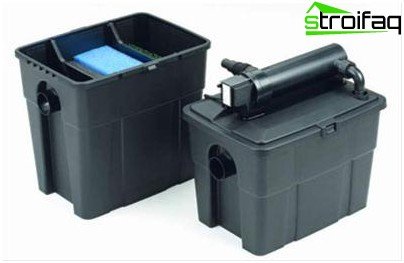
It looks like one of the models of a purchased flow filter
What are filters for ponds
When you start choosing a filter, marvel at their diversity. In order not to “drown” in an abundance of offers and make the right choice, you will have to go through the program of “educational program”. To get started, examine what filters are, how they differ, which device is suitable for what purposes. And then make your choice or use a homemade filter for the pond. By cleaning methods, filters are divided into the following types:
- Mechanical devices that clean a pond of various debris, including natural – fallen leaves, dead plants, and so on.
- Ultraviolet water disinfecting systems that fight the harmful bacteria that live in the pond.
- Chemical orientation, working to normalize the composition of water by cleaning from impurities, toxins.
- Biological type, guaranteeing a natural balance in the reservoir and restoration of the natural environment.
- Combined models that include several or all of the above systems, allowing to achieve perfect cleanliness in a pond. This type of filter is often used for fish ponds, because for the comfortable existence of the underwater inhabitants you need perfectly clean and clear water so that the fish feel good and you can enjoy your water creation with joy.
However, this is not all. Depending on the volume of water intended for processing, the filters for the pond are:
- flowing,
- pressure head.
Both of these types of devices operate on the basis of a water pump. Such models, as a rule, are of a combined orientation, since they are used for large bodies of water.
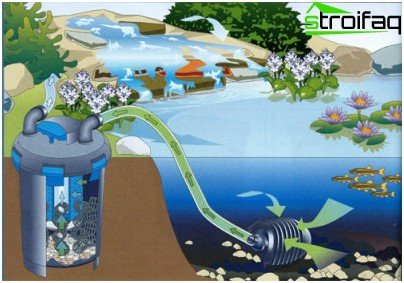
Pressure filter operation
Getting to know the filters
Consider the mechanism of action of flow and pressure filters in more detail.
If the pond is large, then you will need a flow filter for the pond, which is capable of purifying a volume of water of the order of 300 cubic meters. The device includes a pump. The principle of operation of the filter is based on the passage of water through a special container in which purification takes place. The porous filter material, by the principle of a sponge, does not pass through a variety of debris, dead plant cells, other insoluble particles clogging the reservoir. Often, such units combine several cleaning systems, for example, mechanical, ultraviolet and chemical. Having passed through such a multifunctional tank, the water becomes perfectly clean, its composition is normalized.
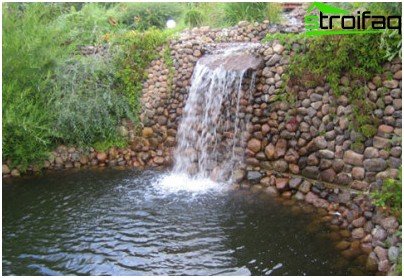
If the cleansing system is skillfully positioned, then you will become the owner of the waterfall
This is important to know! If you will use a flow type filter to clean the pond in which the fish live, keep in mind that the performance of the device may decrease.
You have a small pond, there is no fish in it yet, and have you always dreamed of having, though tiny, but your own waterfall or fountain? Then you need a pressure filter for the pond, which is able to purify up to 60 cubic meters of water. Its “trick” is the ability to supply purified water to a small height – up to 5 meters. Therefore, this miracle aggregate is always on the farm of fans of artificial streams, waterfalls and fountains. Despite its low power, the “baby” is a more complex device than an alternative pressure filter. Although the principle of their work is generally similar.
In the pressure filter, water also passes through a kind of sponge into the biological section or sterilizer. The pressure filter is called because the water with the help of an electric pump enters the upper point (to the height you have planned), and a stream of water enters from the bottom of the pond, where the apparatus is located. As you understand, this type of treatment is ideal for creating structures that imply water outflow and involve a closed type of water circulation. But, as already mentioned, such ponds with striking keys should not be large, otherwise the filter will not cope with the purification of the entire volume.
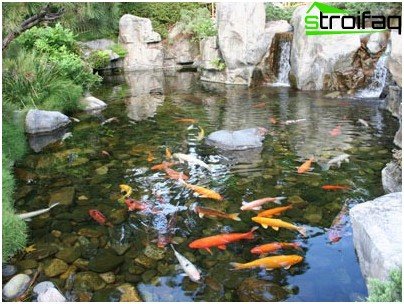
If there is fish in the pond, then you better buy a combined cleaning unit
How to make a homemade water purification filter
If you have a modest budget or a tiny pond that is not inhabited by underwater “inhabitants” or, for example, you want to become the creator of a water purification unit, then you can make a filter with your own hands. Wise reservoir owners say that there is nothing complicated in this process, but the costs will be significantly lower. It is possible that to create a device you only need to purchase an underwater pump, and all other materials can be found in the house and barn.
So, as a reservoir, you can use either a large basin, or a trough, or another container made of plastic. In the lower half of the tank, you need to make a hole about 10 cm high and twice as wide. At the same time, make sure that the bottom is not affected, otherwise the unit will not fully work. Place a flat stone in the resulting armhole. The bottom of the tank (approximately to the level of the upper surface of the stone) needs to be poured with mortar (cement with sand), but so that a runoff to the first level is formed. The frozen mass can optionally be treated with waterproofing mastic. Then you should pick up 4 stones with a diameter of about 5 cm, place them in a tank, cover the structure with a piece of plastic or stainless steel on top. Pour a layer of crushed stone on top, lay the synthetic winterizer and attach the hose coming from the pump. Almost done, it remains to decorate the upper part of the unit, because beauty also matters, doesn’t it?!
How does a homemade device work? Water, thanks to the pump installed at the bottom of the reservoir, is fed through a hose to the reservoir, seeps through a synthetic winterizer, a layer of rubble and already cleared through the cascade flows back into the pond. From time to time, gravel and synthetic winterizer need to be washed from dirt, and as it wears out, it should be changed. Agree, such a home-made filter can be done by any pond owner.?
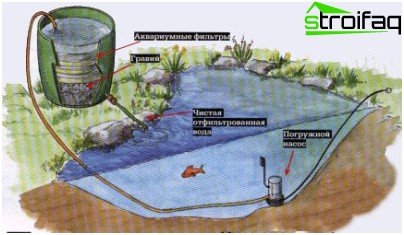
This is how a makeshift pond water treatment system works
A correctly selected or expertly made filter will keep the ecosystem of your reservoir in a stable condition, which means that your water holdings will be clean and beautiful, and the inhabitants of the pond will be healthy and happy..


